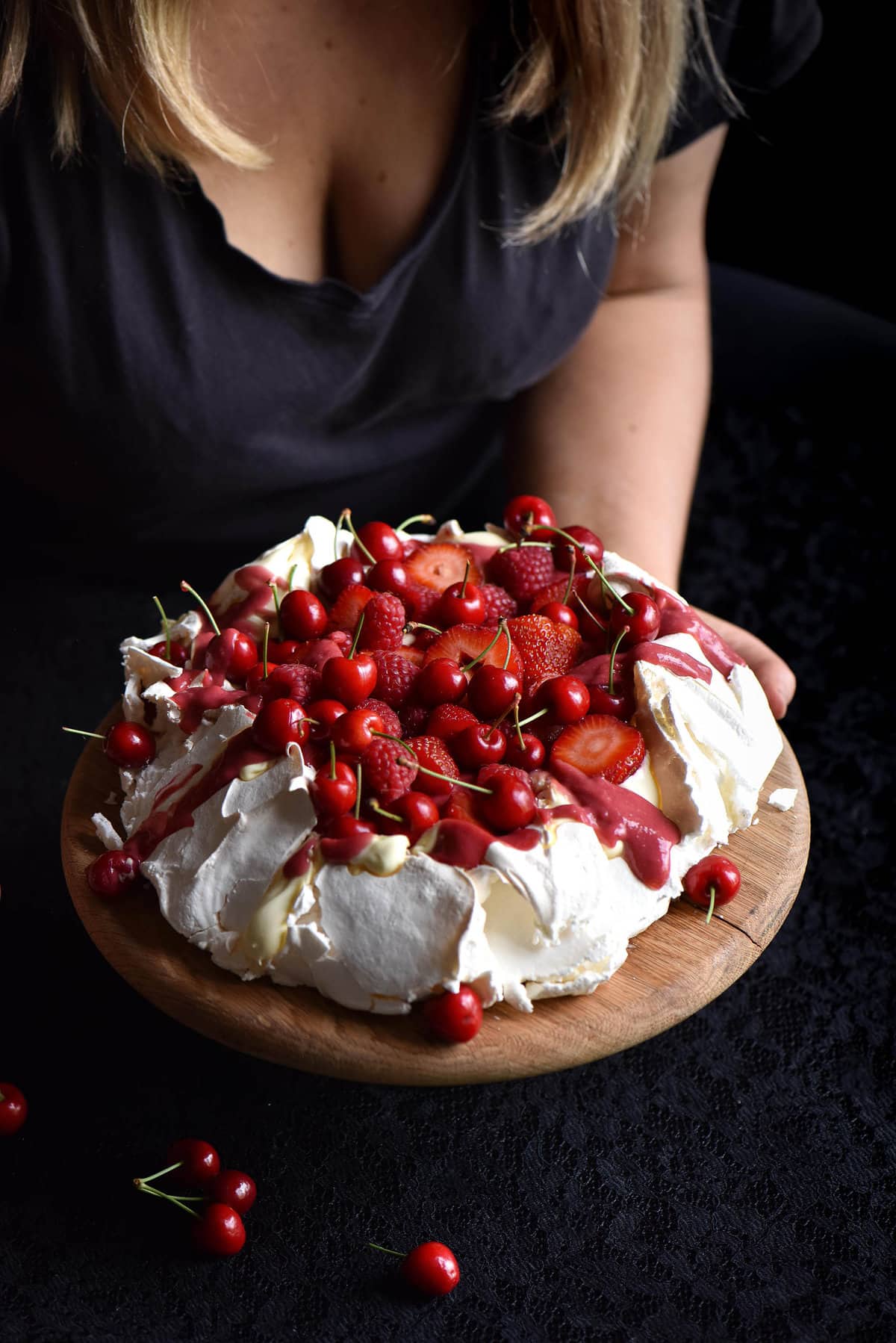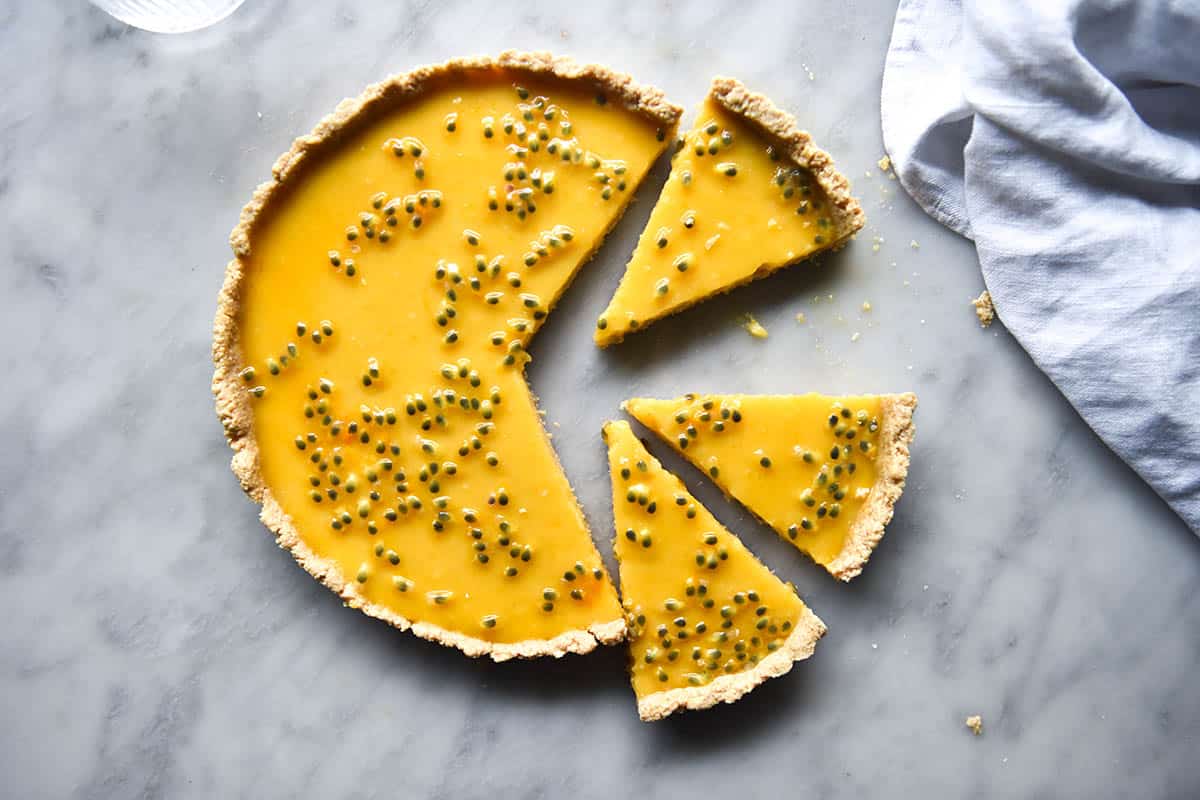
This dairy free lemon curd recipe is actually one from my first cookbook. While I was testing a dairy free option, I discovered that I actually preferred the dairy free version. Without butter, lemon curd has a sharp, bright and clear lemon flavour that is incredible. I loved it so much that this is the only way I make lemon curd these days.

Dairy free lemon curd
This easy lemon curd recipe uses a simple mix of eggs, sugar, lemons and coconut oil. I know what you’re thinking, and no: I promise you can’t taste the coconut oil. It’s an easy, accessible fat source that works perfectly in this dairy free lemon curd as it solidifies similarly to butter. The reason I use it is because it provides a clean, neutral flavour that allows the lemon to shine brilliantly.
To amplify the lemon flavour, the recipe infuses the sugar with the lemon zest before it begins. This is a quick and simple way to amplify the flavour and create layers of lemony goodness.

Can I make this dairy free curd with other fruit?
Yes. You can make this curd with lime or berries. I love the refreshing tartness that citrus brings, but berry curd is equally as delicious (and beautiful, too!). The berry curd also uses some lemon juice to maintain the perfect balance of sweet and sour (as does my passionfruit curd).
In terms of lime curd, it’s worth keeping in mind that because the eggs are yellow and lime juice is not really green, the colour can be a little muddy. In the image below, I used a little bit of green food dye to amp up the colour. Below is an image of the lime curd tart recipe you can find here.
I haven’t tried making a grapefruit curd or an orange curd. While grapefruit would be tart enough on it’s own, orange curd would likely need some lemon or lime juice to keep the flavours in check.

Where can I use this dairy free lemon curd?
- In this gluten free courgette cake with a makrut lime filling and cream cheese icing
- Encase it in the gluten free shortcrust pastry from Intolerance Friendly Kitchen
- Make pavlova with lemon curd, or use the berry curd option in the recipe

Ingredient notes
Caster/superfine or granulated sugar will all work in this lemon curd. I haven’t tried any sugar substitutes (such as monkfruit or allulose) or ‘refined sugar free’ sugars.
Eggs are necessary in this recipe and I haven’t tested a vegan version.
You can use regular or Meyer lemons in this curd. Meyer lemons are a sweeter, less tart variety. While I’m normally a Meyer fan, I quite like the tartness of regular lemons to play off against the sugar.
I PROMISE you can’t taste the coconut oil in this curd. Personally I am not a fan of tasting coconut where it needn’t be either, so I get it. If you’re particularly concerned, use deoderised coconut oil. This can sometimes be called refined or tasteless/odourless. It really tastes of nothing which I find incredibly cool. This makes a great fill in for traditional coconut oil if you don’t like the taste but don’t have an allergy to coconut.

Dairy free curd making tips
Rubbing the lemon zest into the sugar really makes a difference in flavour and is well worth your time.
Cooking the curd on a double boiler and on a low heat is the best way to ensure your curd is nice and smooth.
Room temperature eggs are best for curd making.
Keep a watchful eye on the curd and take it off the heat if it looks like it’s curdling. You can have an ice bath ready to place the bowl in if you’re cautious.
If in doubt, undercook rather than overcook. Under-cooked curd can be fixed, overcooked has little gritty bits of egg white which are not pleasant.
Sometimes you can save a lightly overcooked curd by pushing it gently through a sieve. Hopefully this will aid you in removing some of the overcooked pieces.
The curd is ready when it coats the back of a spoon. It does thicken a little bit as it cools.

More dairy free dessert recipes
- Gluten free, vegan brownie cookies
- Gluten free olive oil cake
- This gluten free banana cake which is accidentally vegan with the lemon icing option
- Gluten free and vegan cinnamon scrolls
- These gluten free blueberry muffins

Dairy free lemon curd
Ingredients
- 110 g (1/2 cup)* caster or white sugar
- Zest of 1-2 large lemons
- 180 ml (3/4 cup)* lemon juice
- 125 ml (1/2 cup)* melted coconut oil
- 4 extra large eggs (45-55g per egg, weighed out of shell)
Instructions
- Place the sugar and lemon zest in a medium heat proof bowl. Use your fingers to rub the lime zest into the sugar. Set the bowl over a small saucepan 1/4 filled with water over a low-medium heat. Ensure the water won’t touch the bowl.
- Add the remaining ingredients and whisk to combine. It will take a few minutes for them to come together. Once they do, continue whisking for 5-10 minutes, or until the curd has thickened and coats the back of a spoon. As soon as it does, remove it from the heat. If you’re cautious, you can plunge the bowl base into an ice or cold water bath to stop the curd from cooking.
- Cover the curd with plastic wrap, flush to the curd itself so it doesn’t develop a skin. Place in the fridge and allow to cool completely (if you’re not using it straight away) before decanting into a clean, airtight container. Use it within a week or freeze it to preserve it for longer.

I am looking forward to recipes, having newly embraced being a vegetarian or rather pescatarian, already gluten and dairy free. Also may I highly recommend a book. The calcium connection by Brunde Broady. Phenomenally important for anyone with intolerances. Please. Take care, great care, how important people like you are to lead the way. Thank you Margaret – New Mexico, USA
I made this recipe for the filling and topping of a lemon blueberry gf cake. The cake was for my sister’s 40th birthday party. The whole family loved it!!! They couldn’t believe it was dairy free! Thank you for the recipe. This one is definitely a keeper ❤️
Hi! Do you use virgin or refined coconut oil for this?
There’s a little note in the ingredients note section but I have used both. I have never tasted the coconut either way but you can use the deodorised/refined version if you are particularly against coconut oil flavour 🙂
Thank you for introducing me to a dairy free version of a family favorite. My grandmother was from Liverpool and I have been making her version for years. I tried your version this afternoon and was delighted and pleasantly surprised! Recently my son went completely gluten and dairy free and I plan on making this for him at Christmas. Since I am a supertaster ( believe me not always a blessing) I could detect a bit of the coconut oil so plan to increase the amount of zest and decrease by a small amount the coconut oil. Again, thank you for showing me how to make this beloved recipe dairy free friendly!